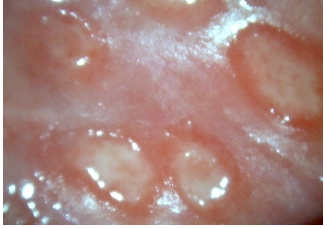Check out today’s Step 2 CK Qmax Question Challenge.
Know the answer? Post it in the comments below! Don’t forget to check back for an update with the correct answer and explanation (we’ll post it in the comments section below).
 A 1-month-old girl presents to the emergency department with emesis. She was feeding well on breast milk until 1 week ago, when she began to have nonbilious emesis immediately after feeding. The episodes have progressed, and are now occurring after every meal with nonbilious projectile emesis. Her parents are surprised that the patient attempts to feed soon after every episode of emesis. They think she has become less active and has lost weight. Her temperature is 36.8°C (98.2°F), respiratory rate is 30/min, heart rate is 160/min, and blood pressure is 88/55 mm Hg. Her abdomen is nondistended and mildly tender diffusely. There is a palpable, mobile, olive-shaped mass in the mid-epigastric region. Ultrasound imaging of the abdomen is shown in the image.
A 1-month-old girl presents to the emergency department with emesis. She was feeding well on breast milk until 1 week ago, when she began to have nonbilious emesis immediately after feeding. The episodes have progressed, and are now occurring after every meal with nonbilious projectile emesis. Her parents are surprised that the patient attempts to feed soon after every episode of emesis. They think she has become less active and has lost weight. Her temperature is 36.8°C (98.2°F), respiratory rate is 30/min, heart rate is 160/min, and blood pressure is 88/55 mm Hg. Her abdomen is nondistended and mildly tender diffusely. There is a palpable, mobile, olive-shaped mass in the mid-epigastric region. Ultrasound imaging of the abdomen is shown in the image.
Laboratory evaluation is most likely to show which of the following?
A. Conjugated hyperbilirubinemia
B. High serum amylase and lipase levels
C. Hyperkalemia
D. Hypochloremic metabolic alkalosis
E. Metabolic acidosis
———————–
Want to know the ‘bottom line?’ Purchase a USMLE-Rx Subscription and get many more features, more questions, and passages from First Aid, including images, references, and other facts relevant to this question.
This practice question is an actual question from the USMLE-Rx Step 2 CK test bank. Get more Step 2 CK study help at USMLE-Rx.com.




D.
D
D
d
D
D
Pyloric Stenosis so should be (D)
D
D. Vomiting causes you to loose HCl which will place your pH level higher. In other words “metabolic alcalosis”
The correct answer is D. Pyloric stenosis often presents at age 3-6 weeks with nonbilious projectile vomiting immediately after meals. Patients exhibit a characteristic desire to be re-fed soon after (“hungry vomiter”). On physical examination, an olive-like mass may be palpated in the mid-epigastrium. Laboratory tests may show a hypochloremic metabolic alkalosis due to a loss of gastric hydrochloric acid and fluid from vomiting. The diagnosis of pyloric stenosis can be confirmed by ultrasound (test of choice) or upper gastrointestinal study.
A is not correct. Unconjugated hyperbilirubinemia has been associated with pyloric stenosis, and may be due to low hepatic glucuronyl transferase levels. The unconjugated hyperbilirubinemia typically resolves after surgical intervention to repair the pyloric stenosis. If conjugated hyperbilirubinemia is present, other etiologies such as ?1-antitrypsin deficiency should be considered.
B is not correct. High serum amylase and lipase levels are seen in pancreatitis, due to a leakage of the pancreatic enzymes out of the pancreas.
C is not correct. Hypokalemia, not hyperkalemia, can be seen with vomiting-induced metabolic alkalosis. This is secondary to the loss of cations (sodium or potassium) in urine to balance the excretion of excess bicarbonate ions.
E is not correct. Metabolic acidosis would be expected if the patient was severely volume-depleted and was in shock with a lactic acidosis. Given the normal blood pressure, that is not the case.
concise
Calvin
Preston